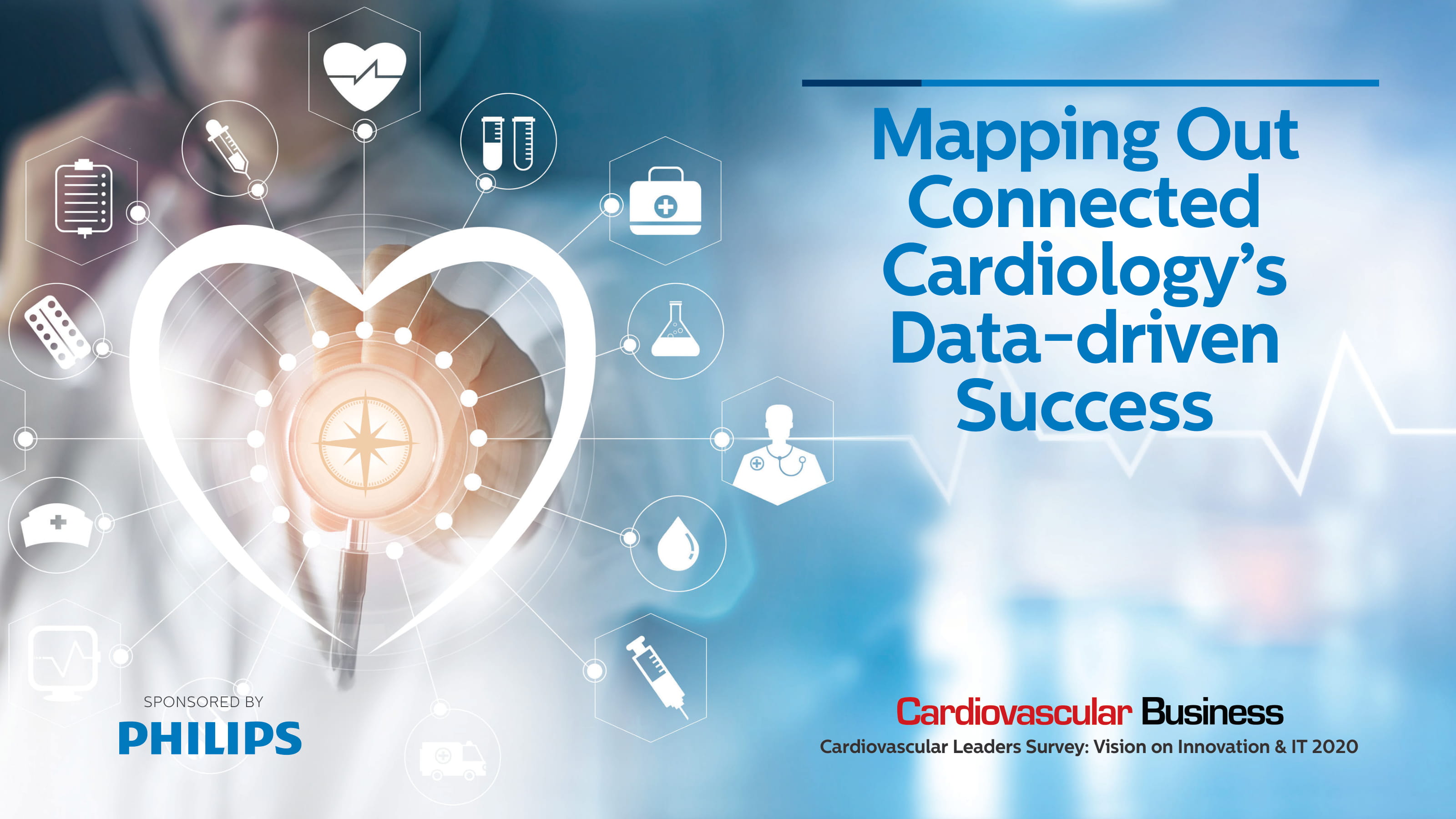Cardiovascular Leaders Survey: What Healthcare Leaders Think
TOP TRENDS facing the CV service line
• Transition to value
• Clinician shortages
• Data-driven healthcare
• Artificial intelligence
• Patient-generated data (wearables, home health equipment, mobile apps)
TOP GOALS for CV service line/practice over the next year
• Reduce costs
• Growth
• Improve quality
• Improve staff satisfaction
• Increase operational efficiency
TOP CHALLENGES facing the CV service line
• Increasing operational performance while improving patient outcomes
• Getting patients into lower cost settings without negatively affecting quality metrics
• Clinician burnout
• Attracting and retaining clinical staff
• Patient satisfaction
TOP ADMINISTRATIVE/CLINICAL CHALLENGES to CVIS adoption/upgrade
• Earning physician support and buy-in
• Vendors unable to support current clinical requirements
• Difficulty integrating cardiology data with EMR
• Uncertain or low expectations for the clinical/patient benefits for adopting/upgrading
• Inability to manage potential changes in the current workflow
TOP FINANCIAL/TECHNICAL CHALLENGES to CVIS adoption/upgrade
• Lack of financial resources
• Lack of IT resources for interfacing and integration
• Vendors unable to support current IT requirements
• Uncertain or low expectations for the IT benefits of upgrading
• Lack of IT resources for hardware and virtualization configuration
TOP TRENDS facing the CV service line
• Transition to value
• Clinician shortages
• Data-driven healthcare
• Consolidation of care providers
• Consumerism
TOP GOALS for CV service line/practice over the next year
• Creating and implementing a comprehensive and consistent approach to cardiovascular services
• Optimize operational outcomes
• Increase patient satisfaction
• Improve quality
• Working toward standardizing on one platform across the health system for EMR and IT systems
TOP CHALLENGES facing the CV service line
• Increasing operational performance while improving patient outcomes
• Getting patients into lower cost settings without negatively affecting quality metrics
• Too little quality face-to-face time with patients
• Building a marketable reputation for excellent outcomes
• Keep up with technology
TOP ADMINISTRATIVE/CLINICAL CHALLENGES to CVIS adoption/upgrade
• Uncertain or low expectations for the clinical/patient benefits for upgrading
• Earning physician support and buy-in
• Inability to connect different vendor devices
• Lack of leaders’ ownership of and commitment to clinical workflow solutions
• Difficulty integrating cardiology data with EMR
TOP FINANCIAL/TECHNICAL CHALLENGES to CVIS adoption/upgrade
• Lack of IT resources for interfacing and integration
• Lack of clear strategy for IT within your organization
• Lack of financial resources
• Uncertain or low expectations for the IT benefits for upgrading
• Lack of vendor understanding
TOP TRENDS facing the CV service line
• Transition to value
• Clinician shortages
• Data-driven healthcare
• Consolidation of care providers
• Patient-generated data (wearables, home health equipment, mobile apps)
TOP GOALS for CV service line/practice over the next year
• Increase operational efficiency
• Growth
• Creating and implementing a comprehensive and consistent approach to cardiovascular services
• Achieve greater standardization of technology across the health system
• Improve processes to deliver higher quality care
TOP CHALLENGES facing the CV service line
• Increasing operational performance while improving patient outcomes
• Attracting and retaining clinical staff
• Clinician burnout
• Reducing readmissions while optimizing length of stay
• Data analytics and management
TOP ADMINISTRATIVE/CLINICAL CHALLENGES to CVIS adoption/upgrade
• Inability to connect different vendor devices
• Lack of administration support or understanding
• Lack of leaders’ ownership and commitment to clinical workflow solutions
• Difficulty integrating cardiology data with EMR
• Lack of clinical resources needed to support an upgrade
TOP FINANCIAL/TECHNICAL CHALLENGES to CVIS adoption/upgrade
• Lack of financial resources
• Lack of clear strategy for IT within your organization
• Lack of IT resources for integrating and integration
• Lack of project-management resources
• Lack of IT resources for hardware and virtualization configuration
TOP TRENDS facing the CV service line
• Transition to value
• Clinician shortages
• Data-driven healthcare
• Consolidation of care providers
• Patient-generated data (wearables, home health equipment, mobile apps)
TOP GOALS for CV service line/practice over the next year
• Improve quality
• Increase operational efficiency
• Reduce costs
• Growth
• Achieve greater standardization of technology across health system
TOP CHALLENGES facing the CV service line
• Increasing operational performance while improving patient outcomes
• Clinician burnout
• Reducing readmissions while optimizing length of stay
• Too little quality face-to-face time with patients
• Getting patients into lower cost settings without negatively affecting quality metrics
TOP ADMINISTRATIVE/CLINICAL CHALLENGES to CVIS adoption/upgrade
• Earning physician support and buy-in
• Lack of administration support or understanding
• Lack of leaders’ ownership of and commitment to clinical workflow solutions
• Difficulty integrating cardiology data with EMR
• Inability to connect different vendor devices
TOP FINANCIAL/TECHNICAL CHALLENGES to CVIS adoption/upgrade
• Lack of financial resources
• Lack of IT resources for interfacing and integration
• Lack of clear strategy for IT within your organization
• Uncertain or low expectations for the IT benefits for upgrading
• Lack of IT resources for hardware and virtualization configuration
Read the report...
Contents
Survey at a Glance
Priorities of the Cardiovascular Service Line
Defining State-of-the-Art CVIS
Key Findings
Demographics
About the Survey
The 16-page report on the 2020 Cardiovascular Business Leadership Survey offers a snapshot of what health system and cardiovascular leaders think about priorities, challenges and trends. Some of it validates, while some enlightens. It all helps guide leadership on a data-rich and insightful journey into the future.


